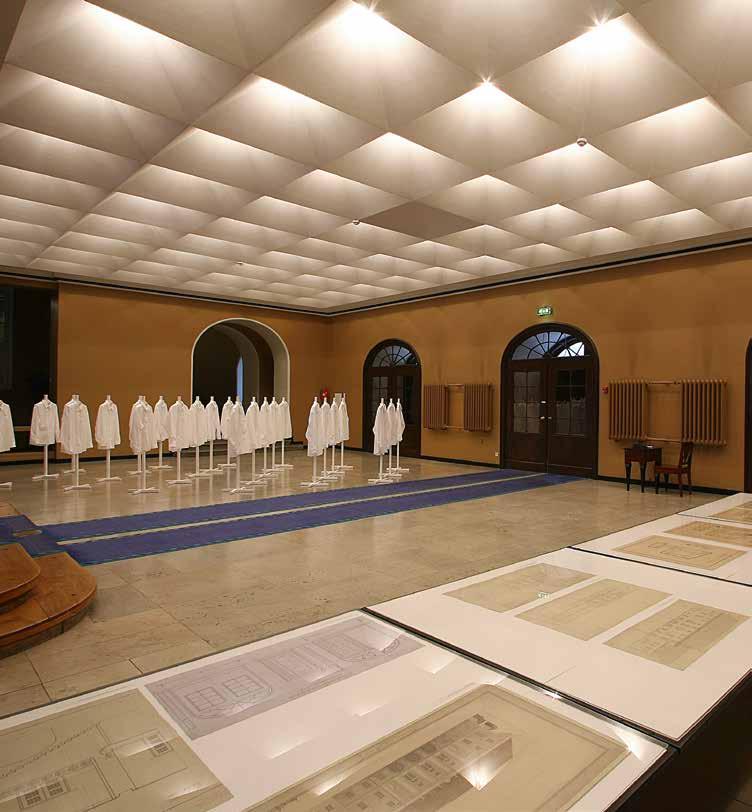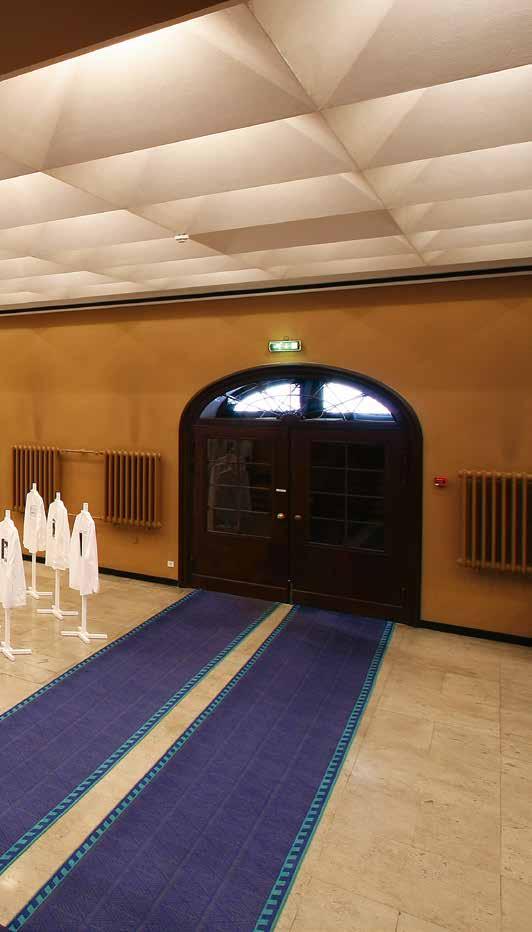
6 minute read
RIIGIKOGU HOOnE 90”
from RUUMIPILT 2012
ruumilabor on loovbüroo, mille asutajateks on sisearhitektid janno Roos ja Andres Labi. Tänaseks on loodud bürookeskkondi, riigiasutuste esindusruume, hotelle, mitmeid kauplusi, kohvikuid ja restorane ning innovatiivseid näitusekujundusi. ruumilabori kaasabil valmis Eesti paviljoni projekt EXPo maailmanäitusele Shanghais.
Ruumilabor is a creative bureau, the founders of which are the interior architects Janno Roos and Andres Labi. By now they have created office environments, official rooms for governmental institutions, hotels, several shops, cafés and restaurants, and innovative exhibition designs. The Estonian pavilion project for the EXPO world exhibition in Shanghai was completed with the cooperation of Ruumilabor.
Advertisement
www.ruumilabor.ee
aadress/address: autorid/authors: kuraator/curator: tellija/client: graafiline disain/ graphical design:
fotod/photos:
Lossiplats 1A, Tallinn janno Roos, Andres Labi (Ruumilabor) Mait Väljas Riigikogu kantselei
Identity
Ruumilabor

ruumilabori riigikogu hoone näituse lahendus oli hästi kerge ja vaimukas, ja seda mitte sisu arvelt.
Mari Kurismaa, sisearhitekt ja ESLi aastapreemiate žürii liige
Arhitektuurinäitus, mis on vormunud kunstiprojektiks, on küll kohaspetsiifiline, kuid rändab edukalt ringi eri paikades ja suudab tahes-tahtmata üllatada ka pahaaimamatut poliitikut.
Mida näidatakse ja miks ja kellele? Janno Roos (JR): See oli päris keeruline ülesanne teha arhitektuurinäitus arhitektuurselt nii nõudlikku ruumi, kus meil seinapinda üldse ei olnudki. Näitus tutvustab riigikogu hoone arhitektuuri: kui me räägime hoonest, siis me peaksime rääkima selle funktsioonist – meil on seadusandlik jõud ehk siis riigikogu institutsiooniks ehitatud maja, mis on 90 aastat vana. Kuidas siduda inimest arhitektuuriga? Me ei pane lihtsalt vanu jooniseid üles, mis oleks klišee või ka ebahuvitav, seal pole piisavalt intriigi – mis selekteerib osa publikust kohe välja, need, kes joonist lugeda ei viitsi, ei taha, ei oska. Näituse taotlus on ennast mitte kohe kätte anda. Koostöös Identity meeskonnaga ründasime teemat: mis on kujund, mis sümboliseerib inimest, kes töötab täna ja on töötanud siin majas 90 aastat. Eks ta üks valgekrae ole! Niisiis printisime triiksärgi seljale arhiivist kopeeritud vanade jooniste lõikeid, vaateid. Näoga hoonesse siseneja poole seisavad lihtsalt särgid, mis tekitas elevust poliitikute seas. Tahtsime teha 101 tegelast, kuid on vähem. originaaljoonised on stendide klaasi all.
Ruumis te mingeid muutusi ette ei võtnud, ka valgustus jäi samaks? JR: autoga ette, tõstsime oma tegelased maha ja kõik. oleme riigikogule kujundanud umbes viis näitust ja tõestanud, et me läheneme omal kombel ja see kas meeldib või mitte. Selle kavandi puhul tekkis intriig ka otsustajate seas, kuraator kahtles, kas idee pole liiga radikaalne või ehk jääb liiga marginaalseks – kuna info ei ole vatmanile prinditud. aga me tahtsime tähelepanu võita. Me peame ikkagi lähtuma inimesest, ka spordihall on inimeste jaoks. Inimene on oluline, ei maksa taandada arhitektuuri lihtsalt igavateks joonisteks. Tellija pool uskus meid kohe, et võiks teha midagi ebatraditsioonilist. Andres Labi (AL): Siin on annus huumorit, mis võiks pigem meeldida. Ma näen mingit seost kaupluste ja näitusekujunduste vahel, kaupa on nii palju, et sa ei suudagi sinna sisse minna. JR: Idee iseenesest peaks kiiresti kohale jõudma. Usun, et keskmine külastaja viibib seal oma kolm minutit, mis on meie jaoks huvitekitajana juba suur saavutus!
Mis särkidest edasi saab – kas toimub mingi oksjon, kas poliitikud kavatsevad neid kandma hakata, või saaksin ise ühe osta? JR: oksjoniidee heategevuseks oli, aga see taandus esialgu organisatoorsete küsimuste taha. Tegelikult on lihtne selle näitusega ringi rännata. AL: Ilusa ilmaga väljas oleks väga lahe, kuidas särgid liiguvad tuules...

väga efektne idee, aga sisu mõttes – ega need särgid eriti hästi loetavad ei olnud, aga saab hakkama!
Leele Välja, arhitektuuriloolane
This architectural exhibition, which has been formed into an art project, is location specific, yet it travels about successfully in different places and manages in spite of itself to surprise even unsuspecting politicians.
What is on display, why and for whom? Janno Roos (JR): It was a rather complicated task to put together an architectural exhibition in a room that is so architecturally demanding, where we had no wall space whatsoever. The exhibition introduces the architecture of the riigikogu building: when we talk about the building, then we should talk about its function – we have a building built for our legislative branch of power, in other words the riigikogu, that is 90 years old. How should people be tied in with architecture? We don’t simply hang up old drawings, which would be a cliché or would also be uninteresting. That doesn’t evoke sufficient intrigue – which eliminates part of the public right away, those who can’t be bothered to read the drawings, or don’t want to, or don’t know how to. The aim of the exhibition is not to give itself away immediately. We attacked the theme together with the Identity team: what is the image that symbolises the person who works in this building today and who has worked here for 90 years. No doubt he would have to be a white-collar worker! Thus we printed sections and views from old drawings copied from the archives on the backs of dress shirts. Just plain shirts face people entering the building, which electrified politicians. We wanted to make 101 characters but there are fewer. The original drawings are behind glass in stands.
Didn’t you change anything in the room? Did the lighting remain the same as well? JR: We pulled up in front of the building, unloaded our characters and that’s all. We have designed about five exhibitions for the riigikogu and proven that we approach things in our own way. People either like it or not. This project gave rise to intrigue among the decision-makers as well. The curator was uncertain whether the idea would be too radical or that it may perhaps turn out to be too marginal – since information is not printed on paper. But we wanted to win attention. We still have to start with people. Sports venues are for people, too. People are important. Architecture should not be reduced simply to boring drawings. The customer believed us right away, that something non-traditional could be done. Andres Labi (AL): There is a dose of humour here that people might like. I see a kind of connection between stores and exhibition designs. There is so much merchandise that you can’t even manage to go inside. JR: In and of itself, visitors should grasp the idea quickly. I believe the average visitor remains at the exhibition for about three minutes, which is a big accomplishment for us already in terms of generating interest!
What will become of the shirts – will there be some sort of auction, will politicians start wearing them, or could I buy one myself?
JR: We originally had an idea for holding an auction for charity but it was set aside for the time being due to organisational problems. It’s actually easy to travel about with this exhibition. AL: It would be real cool outside in nice weather, with the shirts moving in the breeze…

The Ruumilabor Riigikogu building exhibition design was very light and witty, but not at the expense of its content.
Mari Kurismaa, interior architect and artist


A very impressive idea, but in terms of content – those shirts were not that easy to read, but we can manage!
Leele Välja, historian of architecture









